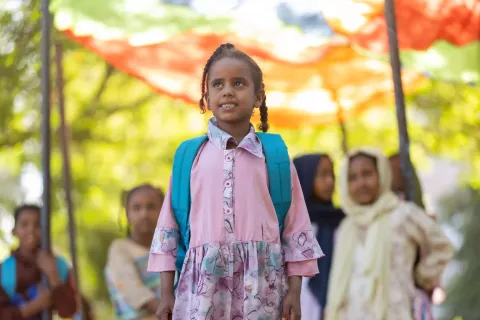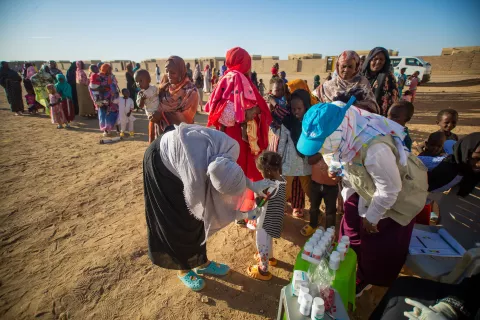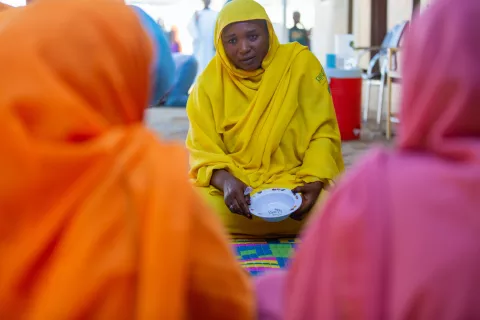Q&A with the health and nutrition team in West Darfur
Tackling high malnutrition rates in West Darfur during the COVID-19 pandemic

- Available in:
- English
- العربية
How can you describe the malnutrition situation in West Darfur?
Malnutrition in West Darfur is prevalent despite years of humanitarian interventions. In reality, on a daily basis in the feeding centers, children are being admitted for malnutrition after routine screening at community or at feeding centers, or during the Expanded Programme on Immunization (EPI). The high rates of malnutrition can be attributed to many factors including the high price for essential commodities notably millet, sorghum, oil peanut and sugar, wheat flour and fuel which significantly reduced the purchasing power of most households hence contributed to reduction in food diversity and the quantity they consume.
As a result of inter communal conflict, an estimated of 45,000 households were displaced from Krinding IDP camp during December 2019/early January 2020, although there was a response from the humanitarian community, the displacement disrupted livelihoods and provision of essential services. In general, there are still a lot to be done especially in regards to IYCFs (Infant and Young Child Feeding), food security since there are many households which are too poor to put a meal on a plate, tribal conflicts within communities, the issue of under five routine vaccinations, all these issues need to be tackled in an integrated manner.
What type of life-saving nutrition services are you providing?
A community management of malnutrition (CMAM) package which includes management of acute malnutrition cases being severe or moderate. We’re also providing community behavioural change through Infant and Young Child Feeding (IYCF).
How many localities are you targeting with your malnutrition interventions?
Our interventions are in all West Darfur localities which are El Geneina, Habila, Foroboranga, Sirba, Kreneik, Jabel moon, Beida and Kulbs.
What challenges are you facing providing these services during COVID-19 pandemic?
Challenges are mostly related to community outreach like routine malnutrition screening at the household level has been suspended as well as the follow up with those defaulters in the programme. Access to sites, movement restrictions has affected programme implementations; shortage of Personal Protective Equipment (PPE); and, dealing with children who accompany their mothers to the COVID-19 isolation center also remains an issue. The recommended physical distance requires additional space or shelter/shade to avoid the overcrowding which is not available in some of the facilities with high caseloads.
What kind of supplies have you delivered and to where (i.e. health centers, stabilization centers)?
Ready-to-use therapeutic food (RUTF), therapeutic milks, routine medication, scales, MUAC (Mid-upper arm circumference) tapes, masks, gloves, and disinfectants for different facilities.
What precautions are you taking to make sure that health workers and those receiving the services are protected?
The staff were oriented by the Ministry of Health and international partners on COVID-19 transmission and prevention mechanisms. Materials have been distributed to be used by staff for: face masks, handwashing facilities, hand sanitizers and gloves. For clients, they are receiving health education focused on COVID-19 prevention, ensuring that physical distancing is respected during service delivery, etc.
COVID-19 IEC (Information, Education and Communication) materials are displayed in strategic places within the facilities to provide and reinforce awareness and safe practices. Some partners are conducting risk communication to the staff and the community in their catchment areas. Task forces have been formed and compliance check lists have been developed and regularly used to assess level of compliance. We also ensure that MUAC tapes and thermometers are properly sterilized after every single use to avoid COVID-19 transmission.
Who are the partners you’re working with on the ground?
UNICEF’s field office in West Darfur works with SMoH (State Ministry of Health), CWW (CONCERN Worldwide), WR (World Relief), SCI (Save the Children International), CRS (Catholic Relief services), SSDHA (SAWA SUDAN) and IMC (International Medical Corps).
UNICEF Sudan's COVID19 response is generously supported by Canada, Germany, Japan, Sweden, United States, and partners contributing to Sudan’s Humanitarian Fund (SHF) and the UN Central Emergency Response Fund (CERF)




